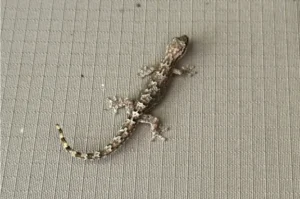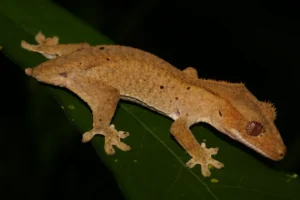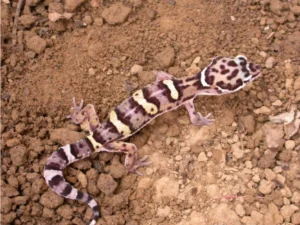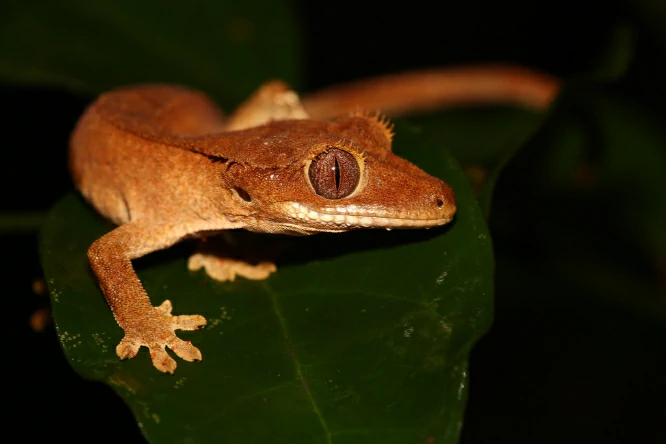You’ve just finished watering your little backyard plants, and as you step back, you notice something small and fast moving on the wall. It’s a gecko, its sticky little toes clinging to the surface like it was made to climb.
If you look closer, you see a thin, papery layer peeling off its back, a shed skin left behind like a tiny ghost of the lizard that just moved. And suddenly, you wonder: do geckos actually eat that shed skin?
Yes, most geckos will eat their shed skin, and they have a few good reasons for it. Shedding isn’t just about looking fresh, it’s also about staying healthy. Old skin can carry bacteria and other tiny organisms, and leaving it around could attract predators or pests. By eating it, geckos get rid of those dangers and even get a little bit of nutrition.
That shed skin is mostly made of keratin, the same stuff that makes up their claws, scales, and even human hair and nails. So while it’s not a fancy meal, it does give them a little protein and other nutrients.
For a small animal in the wild, every little bit counts, and eating shed skin is a way to reuse what they’ve got.
Why Geckos Shed in the First Place
Shedding is totally natural for geckos, and it’s really important for their growth and health. Unlike us, who slowly replace skin cells over time, geckos shed their skin in bigger pieces.

Young geckos shed more often because they’re growing fast, while adults shed less, usually every few weeks or months depending on their species, age, and environment.
Shedding also helps get rid of parasites and damaged skin. If a gecko had old skin with mites or fungus, leaving it could put it in danger. By eating the shed skin, the gecko makes sure those problems don’t stick around in its space.
How Geckos Eat Their Skin
Watching a gecko eat its shed skin is actually kind of cool. They’ll often start at the tail and slowly work their way up, or just gulp down pieces as they peel off.
Some geckos can eat almost all of their shed skin, leaving hardly anything behind. Others might leave bits if they’re distracted or stressed, but they usually try to clean up after themselves.
Not all geckos are the same about this. Some species are more careful than others. Leopard geckos, crested geckos, and tokay geckos almost always eat their shed, while some wild species might leave pieces behind depending on the food they can find or their environment.
Is Eating Shed Skin Safe for Geckos?
Yes, it’s completely safe for them. Their stomachs are built to handle keratin, so eating their own skin won’t make them sick.
It also helps them save nutrients, which is really important in the wild where food isn’t always easy to find.

Sometimes a gecko can have trouble shedding, which is called retained shed. If pieces of skin, especially around toes, tail, or eyes, don’t come off naturally, it can mess up blood flow or cause infections.
In those cases, you might need to help by gently soaking the gecko or carefully removing the stuck skin.
What Happens If a Gecko Doesn’t Eat Its Skin?
If a gecko leaves its shed skin behind, it’s usually not a big deal, especially if it lives in captivity. In the wild, though, leaving skin around could attract predators or parasites.
For pet geckos, it might just mean a little extra cleaning for you. Some geckos aren’t hungry after shedding and may ignore it, but most will eat at least some of it.
Sometimes geckos even eat the shed skin of other geckos, especially if they live together. One might grab a piece from another. It’s not aggressive, it’s just another way to get some extra nutrition.
Why It Looks a Little Gross to Us
Let’s be honest, watching a gecko eat its own skin can seem gross if you’re not used to it. But for the gecko, it’s normal and healthy. It’s kind of like a cat cleaning itself or a bird straightening its feathers.

It might look weird to us, but for geckos, nothing should go to waste. They live in places where every bit of energy counts. Eating shed skin is a smart, simple way to use what they have.
How Often Geckos Shed and Eat Their Skin?
Shedding changes depending on age, diet, species, and environment:
-
Young geckos: Every week or two
-
Adult geckos: Every few weeks to a couple of months
-
Older geckos: Less often, as growth slows
Each time they shed, most geckos will eat at least some of the skin. Sometimes they eat it right away, sometimes they wait a few hours.
Tips for Gecko Owners
If you have pet geckos, here’s what to know about their shedding and skin-eating habits:
-
Provide proper humidity: A humid hide or misting helps geckos shed cleanly. Without enough moisture, they may keep bits of skin that could cause problems.
-
Don’t worry if some skin is left behind: Some geckos don’t eat every scrap. You can gently remove stubborn bits if needed, but never force it.
-
Keep the enclosure clean: Leftover skin can still carry bacteria if ignored. Regular cleaning helps prevent infections.
-
Watch for retained shed: Check toes, eyes, and tail tips. Skin that doesn’t come off naturally can stop blood flow.

Exceptions and Special Cases
Not every gecko will eat all of its skin. Older geckos might leave more behind because they’re not growing as fast and don’t need the extra nutrients.
Geckos with plenty of food might be less likely to eat shed skin, since they don’t need the extra nutrients.
Geckos that are stressed, sick, or undernourished might shed in a weird way and may not eat their skin.
In those cases, keeping an eye on their health and giving them what they need in their environment to survive is very important.
Conclusion
So, do geckos eat their skin when they shed? Yes, almost always. It’s a natural, healthy habit that does a few things: it helps them avoid predators, reuse nutrients, and stay clean.
Watching it might look strange to us, but for a gecko, it’s just part of its daily life.
If you own a gecko, you can feel confident knowing this habit is normal and helpful. Just make sure your gecko’s environment is set up properly, with enough humidity and a clean enclosure, and watch for retained shed around toes or eyes.
Otherwise, your gecko will take care of itself, one nibble at a time, like the little interesting animal it is.
Next time you see that thin, see-through sheet of skin peeling off a gecko, don’t be grossed out, just watch. You’re seeing a smart little animal taking care of itself in a way it’s done for millions of years.
And if it disappears mouth-first, well, that’s just gecko life in action.
Hi, my name is Ezra Mushala, i have been interested animals all my life. I am the main author and editor here at snakeinformer.com.

